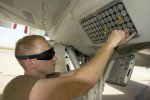- Joined
- Jan 25, 2010
- Messages
- 30,790
- Reaction score
- 15,089
- Gender
- Undisclosed
- Political Leaning
- Undisclosed
The F-35A Is Set to Finally Get Chaff Countermeasures to Confuse Enemy Radars (excerpt)
The commentary at the end (not the article writer is interesting but I believe wrong in the case of the f22. Some quick research indicates the F22 does have chaff countermeasures. I can not confirm that
The U.S. Air Force is hoping to integrate a new, advanced chaff countermeasure onto its F-35A Joint Strike Fighters next year, according to a report. The cartridges, which release radar reflective material to blind and confuse enemy aircraft and air defenses, are a staple across many of the service's other combat aircraft, but have been curiously absent from the stealthy F-35's otherwise extensive defensive suite.
Aviation Week's Defense Editor Steve Trimble was first to spot the detail on Sept. 9, 2019. The Air Force included the information about the new chaff cartridge, known presently as the ARM-210, in a draft environmental impact statement, dated August 2019, regarding the basing of F-35s at various Air National Guard facilities. The report includes a host of information on how the aircraft might impact their surrounding environments, including the potential release of countermeasures, such as infrared decoy flares and chaff.
The commentary at the end (not the article writer is interesting but I believe wrong in the case of the f22. Some quick research indicates the F22 does have chaff countermeasures. I can not confirm that
Contrary to what is stated above, there is nothing ‘curious’ about the fact that the F-35 was designed without chaff or IR flare launchers.
Since its stealthy design was claimed to make the F-35 invisible to radar, there was clearly no need for active countermeasures like chaff to protect it from radar. This same reasoning explains why no other US Air Force ‘stealth’ aircraft, from the F-117 to the F-22 and B-2, are not fitted with any.
By the same logic, the fact that chaff is now planned to be retrofitted to the F-35A merely confirms that, a quarter-century since it was designed, ‘stealth’ is no longer a sufficient guarantee of the F-35A’s survival in combat – if it ever was.

